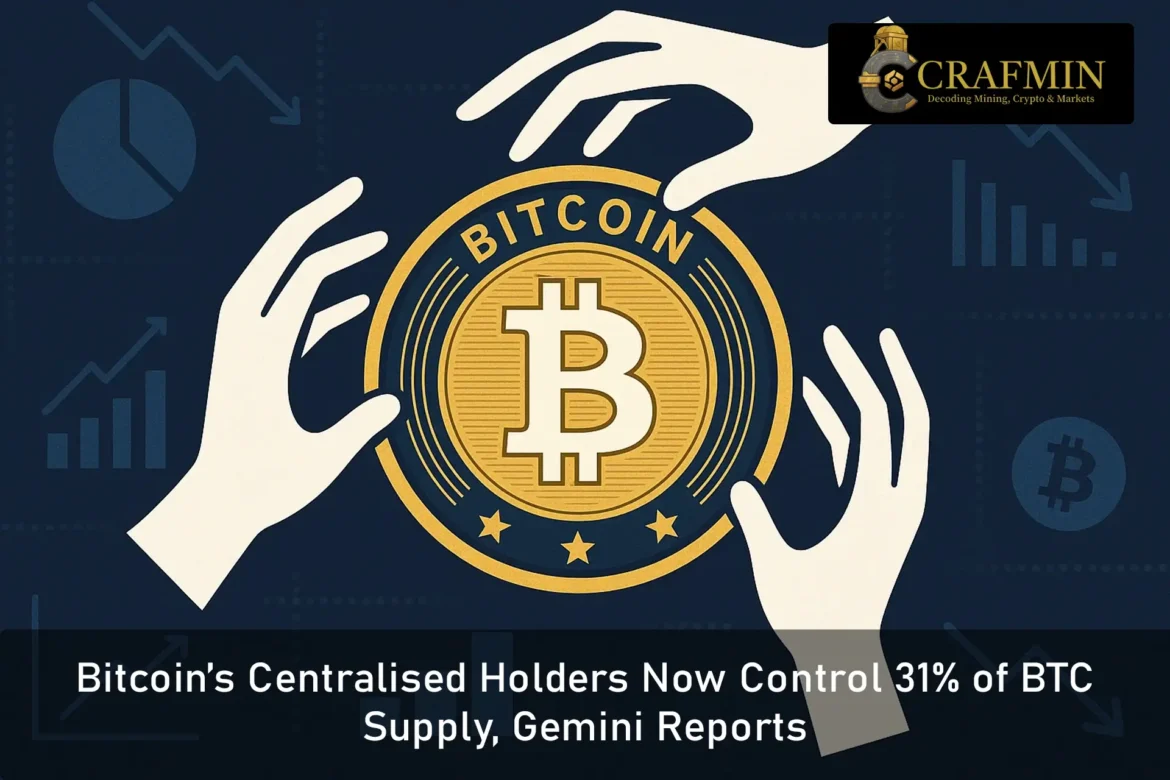Bitcoin, once hailed as the epitome of decentralised finance, is now facing a new kind of scrutiny—not from regulators or sceptics, but from its own growing institutional embrace. A recent report by Gemini reveals that centralised crypto treasuries now hold a staggering 31% of Bitcoin’s total supply.
That’s more than six million BTC—firmly in the grip of exchanges, ETFs, and corporations.

Centralised Entities Now Hold 31% of All Bitcoin, Says Gemini Report ( Image Source: Pngtree )
What Does 31% Ownership Signify?
Gemini’s findings highlight a significant structural shift. With a hard cap of just 21 million BTC, centralised entities now control nearly one in every three coins in existence. This degree of concentration not only challenges Bitcoin’s founding ethos but also reshapes how the market perceives scarcity and value.
Bitcoin was designed as a trustless, peer-to-peer network. But this centralisation trend suggests a pivot towards institutional control—a dynamic many argue mirrors the centralised systems Bitcoin sought to disrupt.
Also Read: Ethereum Foundation Targets Major Security Improvements in Trillion Dollar Upgrade Plan
Why Are Big Players Accumulating Bitcoin?
The reasons behind institutional BTC accumulation are clear: long-term value, hedge strategies, and early positioning in digital assets.
Publicly traded firms like MicroStrategy and Tesla, along with asset managers backing spot Bitcoin ETFs, have steadily expanded their holdings. Major crypto exchanges such as Binance, Coinbase, and Bitfinex also hold enormous BTC reserves, largely as custodians for user assets.
While these players argue their role ensures security and stability, critics warn that it replicates the same custodial bottlenecks that plague traditional finance.
A Shrinking Pool of Circulating Bitcoin
The implications of this consolidation are more than philosophical—they’re economic. As more Bitcoin is locked away in long-term treasuries and cold wallets, the pool of available coins for everyday buyers continues to shrink.
Given that BTC’s supply is already artificially constrained through halving cycles, centralised hoarding tightens liquidity further. This could fuel price surges in the short term but also risks long-term market volatility due to sudden institutional sell-offs or strategic reallocation.
It is what it is. Core’s centralised mandate is evidenced by the censorship of NACKs and a blatant disregard for Bitcoin holders in favor of project owners.
Calling out Core as it is is not antagonistic. It is the truth revealed, unsavory it may be to the ‘antagonised’. https://t.co/1nEZIWmwKI— Liz C ₿ (@cliz30770a) June 10, 2025
Gemini Sounds the Alarm
While not overtly alarmist, Gemini’s report does sound a cautionary note. The platform’s analysts point out that increasing concentration is no longer a fringe concern—it’s rapidly becoming mainstream. And that could impact everything from investor trust to protocol governance.
The core question being asked now is this: Can Bitcoin truly remain decentralised if a handful of entities control such a significant portion of its supply?
From Satoshi’s Vision to Corporate Strategy
Bitcoin has evolved from a cryptographic experiment to a trillion-dollar asset class. But as it moves further into the realm of high finance, the actors shaping its narrative are changing.
Corporations, asset managers, and exchanges aren’t just buying BTC—they’re wielding influence. MicroStrategy, for instance, has turned Bitcoin into part of its brand identity, while BlackRock’s ETF filings helped push institutional legitimacy to new heights.
But this influence is a double-edged sword—advancing adoption while potentially diluting the democratic ethos at the network’s core.
The Price of Legitimacy
Institutional adoption is often celebrated for validating crypto in the eyes of regulators and traditional markets. It brings in capital, reduces volatility over time, and widens mainstream appeal.
But there’s a price: power concentration.
With 31% of BTC held in relatively few wallets, the market becomes more vulnerable to centralised decision-making. A boardroom move or an ETF reshuffling could now have ripple effects across global crypto markets—challenging the idea of decentralised resilience.
Holding Doesn’t Equal Dumping—But Still…
It’s important to acknowledge that many institutions holding Bitcoin are in it for the long haul. These aren’t fast-moving retail traders chasing pumps; they’re custodians with long-term strategies.
Still, long-term holding tightens available supply, dampens liquidity, and amplifies price movements. For smaller investors, it can mean higher entry costs, fewer trading opportunities, and a tilt toward derivatives instead of direct ownership.
That kind of exclusionary dynamic contradicts Bitcoin’s promise of open financial access.
Is a Centralised Future Inevitable?
Some analysts argue that this level of centralisation is an expected outcome of Bitcoin’s maturation. Just as gold is stored in bank vaults, they say, Bitcoin too will need institutions to safeguard and manage its supply.
Others aren’t so sure.
For them, the growing influence of centralised treasuries feels like a betrayal—an erosion of the values that attracted many to crypto in the first place. The tension between these two visions is now more visible than ever.
What This Means for the Everyday Investor
Whether you’re a seasoned crypto user or someone exploring digital assets for the first time, this shift matters. The 31% milestone is more than a statistic—it’s a reflection of where Bitcoin is heading.
If your belief in Bitcoin is based on its role as a decentralised disruptor, then this level of centralisation should raise eyebrows. If you see it primarily as an appreciating asset, then you might welcome the price stability and demand signals this trend could reinforce.
Either way, Bitcoin is entering a new chapter—where decentralisation is no longer guaranteed by design, but must be actively protected by choice.
Final Thought
With over 6.5 million Bitcoins now held by centralised entities, the question isn’t just about how this shift occurred—but where it leads.
Does this herald a stronger, more stable future for Bitcoin—or is it the beginning of a slow march towards the same gatekeeping structures it was created to eliminate?
As institutional wallets grow fatter and available supply continues to shrink, the crypto world must decide whether this is evolution—or erosion.

